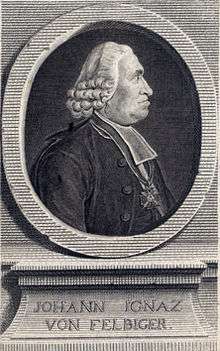Johann Ignaz von Felbiger
| Johann lgnaz von Felbinger | |
|---|---|
 | |
| Born |
Johann lgnaz von Felbinger 1724 |
| Died | 1788 |
| Occupation | priest |
| Known for | reform of the Austrian school system |
Johann Ignaz von Felbiger or John Felbinger (1724-1788)[1] was a minister in the Prussian government and Austrian school reformer, pedagogical writer, and canon regular of the Order of St. Augustine, born January 6, 1724, at Gross-Glogau in Silesia.
History
Johann Ignaz von Felbiger was the son of a postmaster, who had been ennobled by Emperor Charles VI. The death of his parents constrained him, after studying theology at the University of Breslau, to accept (1744) the position of teacher in a private family. In 1746 he joined the Order of Canons Regular of St. Augustine at Sagan in Silesia (now Żagań, Poland),[2] was ordained a priest in 1748, and ten years later became abbot of the monastery of Sagan.
Noting the sad condition of the local Catholic schools, he strove to improve them by publishing his first school-ordinance in 1761. During the private journey to Berlin, in 1762, he was favourably impressed with Johann Julius Hecker's Realschule and Hähn's method of instructing by initials and tables (Literal- or Tabellen-Methode), and became an enthusiastic propagator of this method. A school-ordinance for the dependencies of the monastery of Sagan was issued in 1763, teachers' college was established, and Felbiger's school reforms soon attracted the attention of Catholics and Protestants alike. He was supported by the Silesian minister von Schlabrendorff, and at the latter's request, after a second journey to Berlin he elaborated general school-ordinance for the Catholic elementary schools in Silesia (1765). Three graded catechisms, the joint work of the prior and the abbot of Sagan, appeared in 1766 under the title, Silesian Catechism, and enjoyed a wide circulation. The death of von Schlabrendorff in 1769 marked the end of the Silesian government's educational efforts. Felbiger's suggestions were heeded, however, by King Frederick II of Prussia in regulations issued (1774) for Silesian higher schools.[3][4]
In 1774 Felbinger was invited to Vienna to recommend how to reform school system of Austrian Empire.[4] At the request of the empress, Maria Theresa, he repaired to Vienna, and was appointed General Commissioner of Education for all the German lands of her dominions. This school reforms were aimed to create a sense of national unity of the population of Austrian Empire and set higher education standards. The same year he published general school-ordinance, and in 1775 his most important pedagogical production: Methodenbuch für Lehrer der deutschen Schulen. His school-reform was copied by Bavaria and other German lands and was not without influence on Russia. Considerable opposition, aroused by Felbiger's arbitrariness, developed in Austria against his plan of founding special schools for the neglected instruction of soldiers. Maria Theresa, however, always remained his faithful protectress. But his strictly religious principles education displeased Joseph II, who depraved him his position, assigned him to his provostship at Presburg, and advised him to look after educational intests in Hungary (1782). In 1776 Felbinger and Ilyrian court deputation wrote the procedures for elementary schools for Orthodox children in Banat, which were published on both German and Serbian languages.[5]
The chief peculiarity of Felbiger's too mechanical method was the use of tables containing the initials of the words which expressed the lesson to be imparted. Other features were the substitution of class-instruction for individual instruction and the practice of questioning the pupils. He aimed at raising the social standing, financial condition, and professional qualification of the teaching body, at giving a friendly character to the mutual relations between teacher and pupil. For a list of his 78 publications, which are mainly of a pedagogical character, see Panholzer's Methodenbuch (46-66).
He died on May 17, 1788, at Presburg in Hungary (now Bratislava, Slovakia).
References
- ↑ Granese 2008, p. 16.
- ↑ Rothe 2011, p. 19.
- ↑ Roider 1973, p. 57.
- 1 2 Leger 1928, p. 261.
- ↑ Peti-Stantić 2008, p. 271.
Sources
- Granese, Alberto (2008). La conversazione educativa. Eclisse o rinnovamento della ragione pedagogica. Armando Editore. ISBN 978-88-6081-297-1.
- Ebel, Bartel Edward (1955). The Expression of the Comic in the Plays of Ferdinand Raimund. Department of Germanic and Romanic Languages, Stanford University.
- Roider, Karl A. (1973). Maria Theresa. Prentice-Hall. ISBN 978-0-13-556191-1.
- Leger, Louis (1928). Austria-Hungary. P. F. Collier & Son Company.
- Rothe, Georg (2011). Die Gewerbeschule des Großherzogtums Baden als frühes Modell einer Teilzeitschule im dual-alternierenden System: Einfluss der Polytechnischen Schule Karlsruhe auf die Entwicklung der badischen Gewerbeschule ; Anstöße zur Beseitigung aktueller Defizite in der deutschen Berufsausbildung in Anlehnung an Empfehlungen der Europäischen Kommission. KIT Scientific Publishing. ISBN 978-3-86644-647-2.
- Peti-Stantić, Anita (2008). Jezik naš i. Srednja Europa. ISBN 978-953-6979-54-7.
![]()